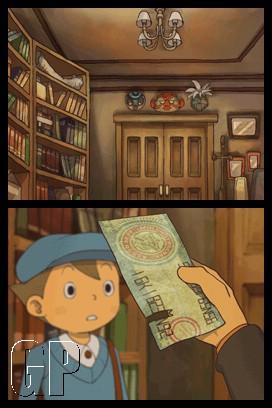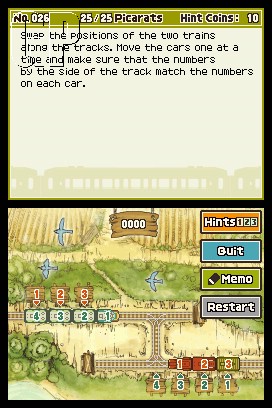Dare you look into Pandora’s Box…or Layton’s Hat…
Reholster your gun, sheathe your sword and Pritt Stick your arch nemesis’s head back onto his neck, the name ‘Professor Layton’ is more likely to make top-hats quiver rather than boots. The eloquent gentleman’s last adventure in Professor Layton and the Curious Village proved that if anything would get you out of a kerfuffle, the puzzle page of The Times and a vast array of teas top trumped fancy assault rifle/chainsaw combos any day. Still, despite not so fond of the old guts and gore approach to glory, it doesn’t mean that things can’t take a darker turn for the teaser of brain teasers.
 Professor Layton and Pandora’s Box begins with the murder of Layton’s late mentor Doctor Andrew Schrader. The number one suspect? An ancient artefact known as ‘The Elysian Box’, an item told to kill anyone who dare look inside it. Sod’s law would have it that said rarity isn’t present at the crime scene, but a ticket to the world famous luxury train ‘The Molentary Express’. With the only lead now in their hands, Professor Layton and his cockney sidekick Luke conduct their investigation wherever the train may take them, determining whether or not this legend holds any truth.
Professor Layton and Pandora’s Box begins with the murder of Layton’s late mentor Doctor Andrew Schrader. The number one suspect? An ancient artefact known as ‘The Elysian Box’, an item told to kill anyone who dare look inside it. Sod’s law would have it that said rarity isn’t present at the crime scene, but a ticket to the world famous luxury train ‘The Molentary Express’. With the only lead now in their hands, Professor Layton and his cockney sidekick Luke conduct their investigation wherever the train may take them, determining whether or not this legend holds any truth.
Those familiar with the Professor Layton series will know the ride they’re in for, except for a few tweaks here and then, but those who love jumping mid-way through will find this easy to pick up and play, with only few minor references to the previous title. The only way to progress through the game is by completing puzzles posed by average citizens, challenging your numerical, lateral, and any method of thinking under the sun. Many of the puzzles lie off the beaten track, and don’t impose an obstacle in the story, yet are necessary to complete to boost the number of completed puzzles.
The steady difficulty curve is welcome to newcomers and experts alike
Those which do impede thankfully aren’t as much of a hassle as those that tease from the sidelines, and if they do prove to be a trial, each one comes with 3 hints that can be bought at the expense of ‘Hint Coins’. Scavenging around the streets like an aristocratic tramp for the quizzical currency isn’t exactly the most prosperous use of time in the game, yet proves to be exceptionally useful for the ambitious willing to outwit the harder challenges.
Those puzzles that stick to the story rails don’t prove too difficult to drain your limited collection of ‘Hint Coins’, yet don’t stand obvious enough to give the noggin time to rest. The steady difficulty curve is welcome to newcomers and experts alike, and what’s better is that the puzzles that are driven by the plot are actually linked to the plot. If you find a locked door, you’ll be forced to find a key for it through brain power, not force it open by answering riddles about the connection between sheep, coasters and a solar eclipse.
 This seemingly obvious improvement of connecting the gameplay to the narrative adds to the atmosphere that is making the series as a whole so whimsical to behold. Characters and locations are drawn and designed with a unique yet recognisable flair, and the addition of more cut-scenes are beautifully animated and always a joy to watch. Even stilted conversations between two cardboard cut-outs of characters are sometimes voiced rather than simply printed along the bottom of the screen. It’s just a shame that such circumstances should is a treat rather than a frequent positive.
This seemingly obvious improvement of connecting the gameplay to the narrative adds to the atmosphere that is making the series as a whole so whimsical to behold. Characters and locations are drawn and designed with a unique yet recognisable flair, and the addition of more cut-scenes are beautifully animated and always a joy to watch. Even stilted conversations between two cardboard cut-outs of characters are sometimes voiced rather than simply printed along the bottom of the screen. It’s just a shame that such circumstances should is a treat rather than a frequent positive.
Written conversations can become monotonous over time when the Professor and his cockney sidekick are recounting conversations of conversations of conversations of previous events. New leads and vital items of importance are, at times, simply dropped on the floor with no evil intentions in mind. The large finale also feels like something of a letdown. It’s filled with nice twists and turns which fully take advantage of the mystery and intrigue built up over the course of the game, and all the pieces of the drama do fit together, just with some fairly unconceivable explanations.
Although the main puzzles provide a satisfying challenge, there are three mini-games on offer which aren’t quite as satisfying. Completing certain puzzles earn collectables to use in the mini-games, such as parts of a camera to reassemble, tea ingredients to brew several types of tea and hamster toys to force a morbidly obese hamster to get into shape. They’re the more unsatisfying types of puzzles, glorified with no overall satisfaction and major rewards.
Although there are some slightly unsatisfying distractions and a plot which feels somewhat hit and miss towards the end, Professor Layton and Pandora’s Box is a step in the right direction for the series as a whole. Although it’s taken a step down in narrative, practical improvements such as plot based puzzles, more animations and steady gameplay curves make it a brilliant addition.
The Bad: Story wavers towards the end, mini-games seem like unnecessary additions
 Silver Y Award
Silver Y Award



